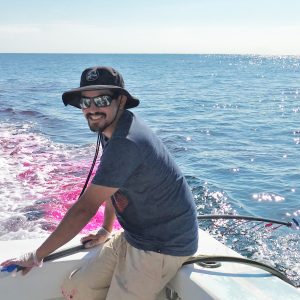This fall, the D epartment of Marine Sciences (DMS) enthusiastically welcomed Dr. Leonel Romero as a new assistant professor in physical oceanography. The DMS began the interview process for new physical oceanographers last spring. Romero’s interview was in March, right before the university closed for the COVID-19 pandemic. This unique situation brought on a set of challenges in starting work at the department, including some delays and getting used to a new way of working, but Romero has been able to do much of his work remotely, and felt welcome despite the situation.
epartment of Marine Sciences (DMS) enthusiastically welcomed Dr. Leonel Romero as a new assistant professor in physical oceanography. The DMS began the interview process for new physical oceanographers last spring. Romero’s interview was in March, right before the university closed for the COVID-19 pandemic. This unique situation brought on a set of challenges in starting work at the department, including some delays and getting used to a new way of working, but Romero has been able to do much of his work remotely, and felt welcome despite the situation.
“A lot of the people in the department have been super helpful with my transition,” Romero says. He looks forward to eventually be able to return to the department in person so that he can meet more of his colleagues. He was able to move into his office and lab space, but his biggest challenge is starting a lab group.
At UConn, Dr. Romero will be continuing his work on upper-ocean processes, ocean waves, and air-sea interaction. Previously, Romero was an Associate Researcher at the University of California Santa Barbara. In 2008 he received his Ph.D. in Oceanography from the Scripps Institution of Oceanography. He received a bachelor’s degree in Physics from the University of California, San Diego, in 2002.
Romero’s journey to becoming a physical oceanographer started early on in his life. He grew up in Mexico City and always loved math and physics. Before high school, he came across Hawking’s Brief History of Time and was fascinated by it, which led him to pursue an education in astrophysics. Romero moved to San Diego for university, where he became fascinated with the ocean through surfing and his work. He became an undergraduate research assistant at Scripps Institution of Oceanography. “We were trying to understand the drifts of floats in the Southern Ocean,” Romero said, “It’s important to understand those currents because they regulate our climate, and I found it super rewarding to study ocean physics and the environment.” When he took astrophysics classes, he found them too abstract, and became passionate about oceanography.

While pursuing his Ph.D. in oceanography, Romero focused on air-sea interactions. “In order to improve our understanding of how weather and climate work, we actually need to understand ocean waves and I found that fascinating, and I pretty much dedicated most of my career towards that.” Romero moved to Santa Barbara as a researcher to continue work on upper-ocean and interdisciplinary processes, such as utilizing runoff as a tracer for an ecological project. Romero decided to pursue a tenure-track position after teaching a class on waves, tides, and estuarine processes. He was drawn to UConn because of our department’s work focusing on air-sea interactions.
At UConn, Romero will work on an NSF-funded project to study interactions between waves and fronts, and their correlation with wave breaking. “If you have fronts, you happen to have more wave breaking, and so that has potential implications for how the CO2 gets into the ocean.” This project is “purely numerical with coupled ocean wave models,” which can all be done remotely. Romero also plans on starting an observational/modeling group at Avery Point in the future.
Outside of research, Romero has been enjoying the scenic CT coastline. He loves to surf and go on walks in the area. As a seafood lover, he has been enjoying the abundance of good local seafood.